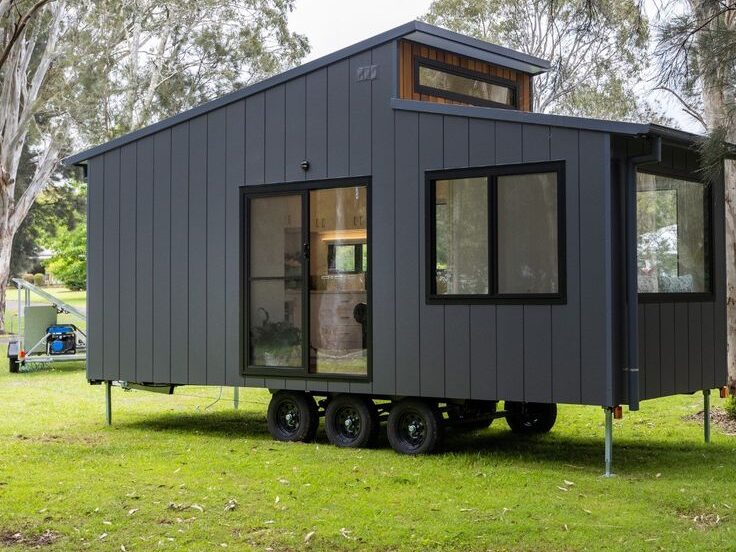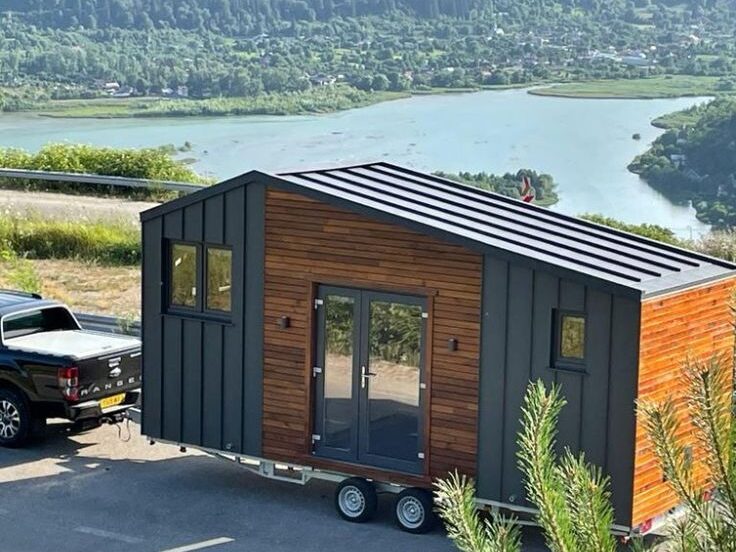How big can a tiny house be? It’s a question every future builder or buyer must ask. This guide explores the size, dimensions, and legal constraints around the world. Whether you’re downsizing, off-grid dreaming, or planning a holiday resort this article is your go-to resource. Read on to get the full breakdown.
How Big Can a Tiny House Be?

While the definition varies by country and building code, a tiny house is generally considered to be any residential structure under 400 square feet. These small yet functional homes have grown in popularity due to rising housing costs, a push toward sustainable living, and the desire for mobility.
Whether you want a home that’s mobile, off-grid, or simply more efficient, understanding what size is a tiny house, how much a tiny house weighs, and what are the dimensions of a tiny house is key before you begin your journey.
There are two main types of tiny homes: tiny houses on wheels (THOWs) and tiny houses on foundations. Each has distinct size limitations and structural requirements based on road safety rules, zoning laws, and local building codes.
What Size Is a Tiny House?
While “tiny” is a flexible term, most tiny homes range between 100 and 400 square feet. The actual livable space depends on the layout, type of build, and whether it’s on wheels or a permanent foundation.
To answer what are the dimensions of a tiny house are, here are the most common standard measurements for THOWs:
- Width: Maximum of 8.5 feet, allowing legal road travel without special permits.
- Height: Up to 13.5 feet, to safely clear overpasses and bridges.
- Length: Typically no longer than 40 feet, depending on the towing vehicle and regional transport laws.
For stationary homes, these limits are more flexible but must meet local building codes.
Hence, before choosing a layout, it’s important to understand not just how big can a tiny house be, but also where and how you intend to live in it. A tiny home built for weekend getaways may look very different from one designed for full-time family living.
How Much Does a Tiny House Weigh?

When planning a tiny mobile home, knowing how much does a tiny house weigh is just as important as knowing its size or layout. Weight impacts not only transportation and fuel efficiency but also legal compliance and safety.
On average, the dry weight or the weight without furniture, water, or personal belongings of a tiny house, ranges from 10,000 to 15,000 pounds (4,535 to 6,804 kilograms). However, once fully loaded with appliances, furniture, and personal items, the total weight can be significantly higher, often exceeding 16,000 pounds. This increased load may require a heavier-duty trailer and towing vehicle, especially for long-distance travel.
Factors Influencing Weight
Several factors determine the total weight of a tiny home:
- Building Materials: Homes made from heavier materials like metal or hardwood weigh more than those built from lighter wood or composites.
- Appliances & Fixtures: Full-size appliances, water tanks, or solar panels add substantial weight.
- Design & Structure: Multiple levels or lofts increase both structural weight and the need for stability.
Why Weight Matters
Understanding the weight of your tiny home is crucial for road safety, transportation logistics, and legal compliance. Exceeding certain weight limits may require special permits or commercial-grade trailers. Proper weight distribution also prevents accidents during transit.
In short, knowing how much does a tiny house weigh helps ensure your build remains mobile, safe, and legally roadworthy essential for a stress-free tiny living experience.
Country-Specific Regulations
Understanding how big can a tiny house be isn’t just about design, it’s about law. Every country enforces its own rules on dimensions, mobility, and livability.

United States
In the United States, the size of a tiny house depends on whether it moves or stays in one place. For houses on wheels, the United States Department of Transportation limits the height, width, and length for safe travel on roads. Appendix Q of the International Residential Code says a tiny house is any home under 400 square feet, excluding lofts. If you build your tiny house on a foundation, you must follow local building rules. Some tiny homes can be classified as recreational vehicles if they’re under 400 square feet, but using them as a full-time homes for a long time may change that status. Size, weight, and height also affect how easy and legal it is to move the house. Always check local rules to make sure your tiny house is legal and safe.
Size Requirements:
- Max height: 13.5 ft (4.12 m)
- Max width: 8.5 ft (2.59 m)
- Max length: 40 ft (12.19 m)
- Max length with vehicle: 65 ft (19.81 m)
- Max floor area: 400 sq ft
Australia
Australia doesn’t have a single definition for what size is a tiny house, but most are under 50 m². A tiny house on wheels (THOW) must comply with vehicle regulations, limiting its height, width, and total weight to ensure safe towing. Fully loaded, they must not exceed 4.5 tonnes. Though lofts are often excluded from floor space, their inclusion boosts usable living areas. Compliance varies by state, so engaging local councils and code experts is crucial. Australians love tiny homes for mobility, eco-conscious living, and minimalism. The size directly influences whether your house qualifies as a temporary dwelling or a permanent one.
Size Requirements:
- Max height: 4.3 m
- Max width: 2.5 m
- Max length: 9 m
- Max trailer weight: 4.5 tonnes
- Typical size: 10–50 m² (107–538 sq ft)
Europe
How big can a tiny house be in Europe? The answer varies widely. Most European countries don’t yet have dedicated tiny house legislation. In the UK, THOWs must meet vehicle size standards to be road-legal without special permits. France limits weight to 3.5 tonnes, while in Germany, you cannot live permanently in a mobile tiny house without a registered address. Denmark treats parked THOWs as permanent structures after six weeks. Many tiny European homes fall within 50 m², but urban and rural zoning laws differ. For safety and legality, researching national and municipal regulations is essential before building or relocating.
Size Requirements:
- Max width (UK): 2.55 m (8.37 ft)
- Max length (UK): 7 m (22.97 ft)
- Max weight (France): 3.5 tonnes
- Max area (general): 50 m² (538 sq ft)
- Check for local variations
Conclusion
If you’re wondering how big can a tiny house be, remember it depends on how and where you plan to use it. In most places, a tiny house is under 400 square feet. Whether it’s built on wheels or a foundation, you’ll need to follow local rules on size, weight, and zoning. Understanding these limits helps you stay safe, legal, and ready to enjoy your new home.
If you’re looking for a reliable tiny house builder, Capsule Castle is the best choice. We create dome-shaped tiny homes that match your vision. Choose from single-deck or double-deck capsule homes. Our houses can be installed anywhere; on mountains, in forests, or by the sea without traditional foundations, reducing waste. With fast shipping and easy assembly, our modular kits snap together like building blocks. Capsule Castle’s stylish design, 360° windows, and strong wood-aluminum blend offer quality and beauty. Buy your dream tiny dome-shaped space capsule home today with Capsule Castle.





